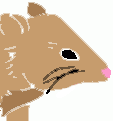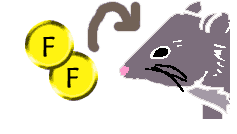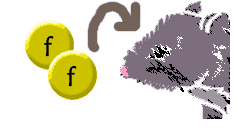The Dreaded Double Hybrid

 Mr.
and Mrs. Mouse both had one copy of each allele for teeth (one wild-type copy,
one vampire fangs copy). In that sense, they were hybrids for the vampire
allele. Well, they are also hybrids for the fur allele - one copy of the wiry fur allele and one copy of the fluffy
fur allele. (And let's assume that fluffy
fur is a recessive trait, like vampire fangs).
Mr.
and Mrs. Mouse both had one copy of each allele for teeth (one wild-type copy,
one vampire fangs copy). In that sense, they were hybrids for the vampire
allele. Well, they are also hybrids for the fur allele - one copy of the wiry fur allele and one copy of the fluffy
fur allele. (And let's assume that fluffy
fur is a recessive trait, like vampire fangs).
 |
 |
Now there are two pairs of alleles in the mother's genotype. One allele pair has the vampire/non-vampire teeth. The other pair has flat/fluffy fur. But each egg gets only 1 allele from each of the pairs. So across the top of the Punnett Square, where we list all possible kinds of eggs, we have to list all possible combinations of one-allele-from-each-pair. This is just like the possible combinations of heads and tails on two coin flips:
 +  |
 +  |
 +  |
 +  |
And the father has the same two allele pairs. To make a baby, Mr. Mouse flips his two coins, and Mrs. Mouse flips her two. We can make a Punnett Square to help us figure out what their babies should look like.
I am guessing you have already seen this kind of Punnett Square in your lecture or your textbook or both. If you already understand how it works and can reproduce it on your own, you could skip this page. If not, do not "look up" how to do a Punnett Square. I will ask you some leading questions, but the idea is for you to figure it out, then you won't need to memorize it or look it up.
As you know by now, the top needs to list all of Mom's possible egg types (her 'menu' of choices). How many are there? 1. all dominant ("wild-type") egg 2. fangs with wild-type fur 3. fluffy fur with wild-type teeth 4. fangs and fluffy fur. So that makes a 'menu' of four choices. Likewise for Dad.
1. Put Mom's egg choices along the top. Put Dad's sperm choices along the side. (Put the teeth gene first and the fur gene second). 2. That was the hard part. Now that we have the borders of the table done, you can fill in the middle. Each square represents 1 baby, and each baby is going to get one fur and one teeth allele from Mom, and one fur and one teeth allele from Dad. List all four alleles in the box for each box. This gives you the genotype. 3. Now look at each box. Using the dominance rule, what should each baby look like (i.e., what's its phenotype)? |
If you followed these steps faithfully, you should end up with 9 wild-type babies, 3 with fluff, 3 with fangs, and 1 fluffy vampire (poor kid!)
This is the famous 9:3:3:1 ratio.
Copyright University of Maryland, 2007
You may link to this site for educational purposes.
Please do not copy without permission
requests/questions/feedback email: mathbench@umd.edu